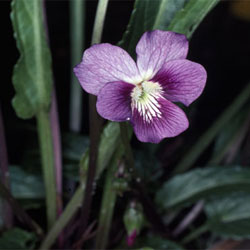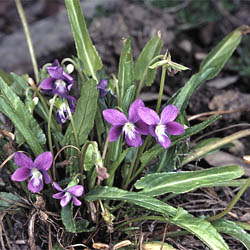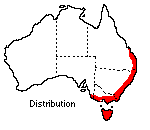Viola betonicifolia
 |
 |
Mountain Violet, Showy Violet
The genus Viola is large with over 400 species worldwide. The majority of these grow in temperate parts of the northern hemisphere with only 11 species occurring naturally in Australia. One of these, Viola betonicifolia, occurs over much of the moderate rainfall areas of eastern Australia, extending from Tasmania to Cape York. It also occurs in Papua-New Guinea. Several exotic species have become naturalised.
 Plants
are often found in damp, shaded forest habitats, but they may also occur in
more open sclerophyll forest or on grassy hillsides, growing well on cleared
land not heavily grazed. Plants occur singly although clusters are more common.
Individual plants have a tufted appearance growing from 5-40 cm high depending
on local conditions. When found in an exposed situation, plants may die down
to a perennial rootstock, particularly during a severe winter or drought.
Plants
are often found in damp, shaded forest habitats, but they may also occur in
more open sclerophyll forest or on grassy hillsides, growing well on cleared
land not heavily grazed. Plants occur singly although clusters are more common.
Individual plants have a tufted appearance growing from 5-40 cm high depending
on local conditions. When found in an exposed situation, plants may die down
to a perennial rootstock, particularly during a severe winter or drought.
Viola betonicifolia will often set seed without obvious flowering, the plant producing some small, self-pollinating flowers that never open. This phenomenon is known as cleistogamy. Normal flowers are also produced. Plants flower prolifically, especially in spring. Flowers are usually 2 cm across and held singly above the foliage on slender stems. The colour may vary from pale purple to violet, fading with age. Leaves are 3-30 cm long, with a long petiole and a leaf blade resembling an arrow head.
As with many plants with a wide natural distribution, best results are often obtained by growing a local form or one from a location similar to the area in which it will be cultivated. New plants can be grown easily from seed that may be available on cultivated plants throughout the year. Like other Viola species, once a plant is established in the garden self-sown seedlings appear around the mother plant in a short time. Division of large plants during winter and the use of root cuttings are other possible methods of increasing limited stocks or maintaining selected forms.
Pests and diseases have not been observed although it is suspected that earwigs cause some damage by eating flowers.
A rockery is an ideal site for Viola betonicifolia and it can be used to advantage in small pockets of fairly deep soil where the thickened main root can establish.
Text by Peter Ollerenshaw, ANBG (1981)
Name meaning: Viola betonicifoliaViola - the Latin name for the Violet flower; betonicifolia - from Betonica, a genus of plants now included in Stachys; and folia from the Latin for leaf, alluding to the leaves being similar to those of Betonica |
![An Australian Government Initiative [logo]](/images/austgovt_brown_90px.gif)

